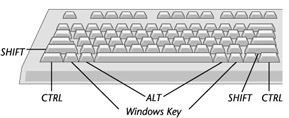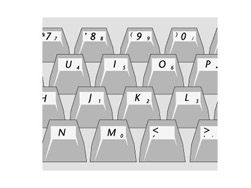Using the Modifier Keys
The standard keys discussed in the previous section are mostly easy enough to use: to get an a , you press the [A] key; to get a 1, you press the [1] key; and so on. To use a keyboard shortcut, you typically press one of the modifier keys ”keys that modify the effect of the key you press. (That sentence says typically because a few keyboard shortcuts don t use any modifier key, as you ll see later in this book.)
Standard keyboards for Windows PCs include four modifier keys (Figure 1-2):
-
[Shift] The [Shift] key derives from the typewriter and changes the case of the letter. The name comes from the [Shift] key on a typewriter physically shifting the typewriter mechanism ”either lifting the platen or lowering the typebars so that the top part of the typebar (containing the uppercase letter), rather than the lower part of the typebar (containing the lowercase letter), strikes the platen. (The typebars are the metal bars containing the letters . The platen is the roller around which the sheet of paper is wrapped and fed, and against which the typebars strike.)
-
[Alt] The [Alt] key alters the keypress . In Windows, [Alt] is used to access accelerator keys on menus and other command bars (such as toolbars ). For example, to display the File menu in many applications, you press [Alt] - [F] .
-
[Ctrl] The [Ctrl] key (pronounced control ) is used in Windows to trigger keyboard shortcuts. For example, to issue a Print command in many applications, you can press [Ctrl] - [P] .
-
The key is used for shortcuts that involve Windows itself rather than the applications that run on it. For example, you can press - [R] to display the Run dialog box or - [Break] to display the System Properties dialog box.

Figure 1-2: Standard PC keyboards have four modifier keys: [Shift] , [Alt] , [Ctrl] , and .
[Ctrl] , [Alt] , and [Shift] can be used in combination, thus producing many more key combinations ”for example, [Ctrl] - [M] , [Ctrl] - [Alt] - [M] , [Ctrl] - [Alt] - [Shift] - [M] , [Ctrl] - [Shift] - [M] , and [Alt] - [Shift] - [M] . The more keys in a combination, the harder it is for most users to press, but the less chance that any user will press that combination by accident . isn t normally used in combination with other modifier keys, although it is possible to program Windows to recognize such key combinations.
Many laptops include another modifier key on their keyboard: the function ( [Fn] ) key, which is typically used to provide additional functionality on a keyboard that doesn t have enough keys for each separate function. For example, pressing [Fn] - [F5] on some laptops decreases the screen brightness, and [Fn] - [F6] increases it.

A laptop keyboard may also have an embedded keypad to provide the functionality of the keypad on a full- size keyboard. The embedded keypad usually appears on the right-hand side of the keyboard, with the letter J doubling for 1, K for 2, and L for 3. You press a numeric lock key ( [NumLock] ) to activate the keypad function.
EAN: 2147483647
Pages: 117